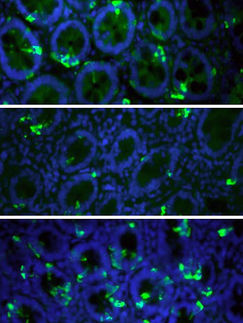New Regulator of Glucose Transport in Adipose Tissue Discovered
These findings could help to develop new therapeutic approaches for treating type 2 diabetes and obesity
The role of the adapter protein Picalm in the development of Alzheimer's disease is well known. Now, researchers from the German Institute of Human Nutrition Potsdam-Rehbruecke (DIfE), the German Center for diabetes Research (DZD), ETH Zurich, and the University of Cambridge have, for the first time, investigated Picalm's function in white fat tissue and its significance for metabolic health. They demonstrated that reduced Picalm expression improves insulin sensitivity and glucose transport in fat cells. These findings, recently published in Molecular metabolism, could help to develop new therapeutic approaches for treating type 2 diabetes and obesity.
Investigating the Mechanisms of Glucose Uptake
Recent research has revealed that insulin resistance and associated metabolic disorders are likely caused by impaired insulin-stimulated glucose uptake via the glucose transporter GLUT4 rather than defects in the upstream insulin signaling pathway. Understanding the metabolic pathways related to the GLUT4 transporter is a promising path for identifying new therapeutic targets.
In preliminary research, the DIfE team led by PD Dr. Heike Vogel identified Phosphatidylinositol Binding Clathrin Assembly Protein (Picalm) as one of the genes with the highest gene expression changes in transcriptome analyses in adipose tissue of diabetes-prone and diabetes-resistant mice. Picalm is a gene associated with Alzheimer's disease and encodes an adapter protein expressed in all cells. However, its role in adipose tissue and metabolic health remained unexplored until now.
Combination of Methods in Mice, Humans, and Cells provides new Insights
The researchers studied whether reduced Picalm expression in white adipose tissue correlates with improved glucose homeostasis. To better understand Picalm's role in metabolic regulation and its potential as a therapeutic target for obesity and T2D, the DIfE scientists used various methods. They compared Picalm expression in white adipose tissue of diabetes-prone and diabetes-resistant mice, as well as individuals with varying body mass. They also investigated how Picalm expression is affected by dietary interventions, such as intermittent fasting in mice and bariatric surgery in obese individuals. In a cell culture model, they manipulated Picalm levels in precursor (pre-adipocytes) and mature adipocytes to study its impact on GLUT4 translocation from an intracellular reservoir to the cell surface, the insulin signaling pathway, and adipogenesis.
Picalm as a Promising Target for Improving Glucose Homeostasis
The results show, for the first time, that Picalm regulates both GLUT4 translocation and insulin signaling pathways in adipocytes. Interestingly, reduced Picalm expression enhances insulin-mediated GLUT4 translocation and insulin signaling. The researchers also demonstrated that Picalm influences the maturation of adipocytes, indicating distinct functions in pre-adipocytes and mature adipocytes.
"We discovered a new role for the adapter protein Picalm in regulating glucose homeostasis and insulin signaling. Notably, Picalm expression is influenced not only by genetic predisposition to T2D but also by dietary interventions. Unlike other known regulators of the insulin signaling pathway, Picalm affects not only signal transduction but also the cellular transport processes necessary for glucose uptake," summarizes the first author Jasmin Gaugel.
In future research, the DIfE team plans to explore Picalm's effects in skeletal muscle, where it has already shown a strong influence on muscle cell differentiation. "Picalm is a very exciting therapeutic target. To further investigate its metabolic role, we plan to study transgenic animals with muscle-specific deletion of Picalm," explains PD Dr. Heike Vogel. The long-term goal is to develop drugs that specifically modulate the function of Picalm in order to improve glucose homeostasis and reduce the risk of T2D.
Original publication
Jasmin Gaugel, Neele Haacke, Ratika Sehgal, Markus Jähnert, Wenke Jonas, Anne Hoffmann, Matthias Blüher, Adhideb Ghosh, Falko Noé, Christian Wolfrum, Joycelyn Tan, Annette Schürmann, Daniel J. Fazakerley, Heike Vogel; "Picalm, a novel regulator of GLUT4-trafficking in adipose tissue"; Molecular Metabolism, Volume 88























































